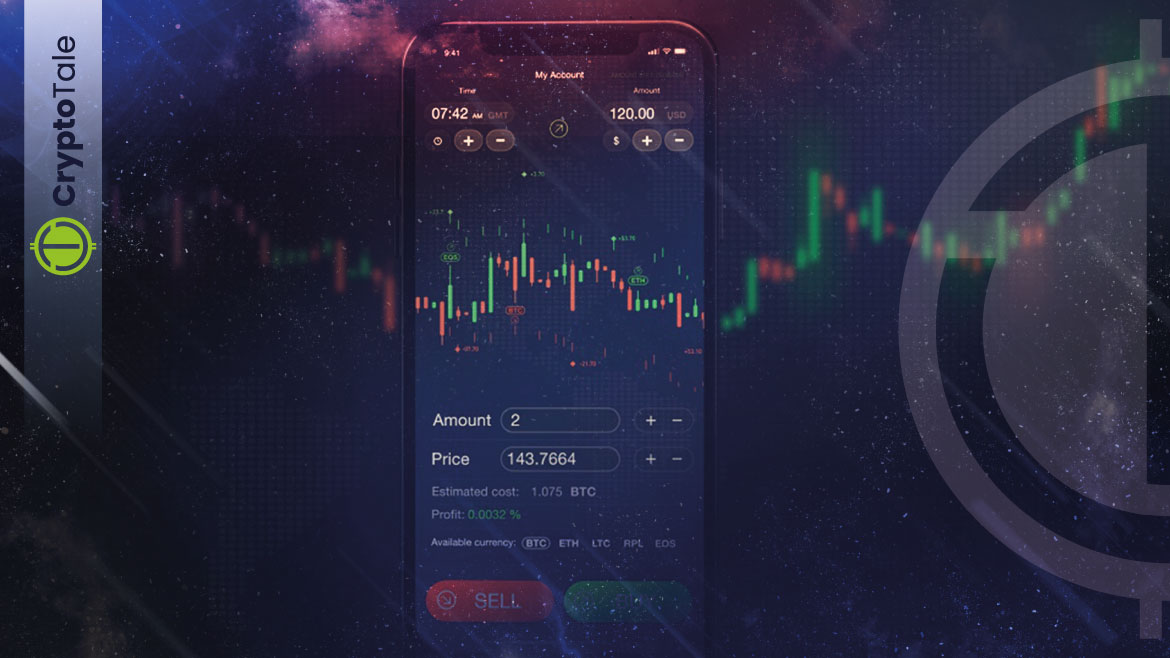
The intraday volatility of the cryptocurrency market makes it ideal for scalp traders, who can enter and exit numerous trade positions a day. Furthermore, the long-term price movement of the majority of cryptos in the market, such as Bitcoin (BTC), Ethereum (ETH), and countless others means that medium to long-term traders can also generate a profit trading cryptos.
This article will take a look at everything that you need to know to get set up and start trading cryptocurrencies.
What are Cryptocurrencies?
Cryptocurrencies are digital tokens or coins that are transacted on top of a blockchain network, which is a distributed or decentralized record keeping framework. The first cryptocurrency to enter into the market is Bitcoin in 2009. Since then, there have been thousands of cryptos that have been created and entered the market.
Each cryptocurrency may have a different purpose to others in the market. Some might be utility tokens for a blockchain platform that grants the holder access to platform-specific services and products, while others may just be a project that was originally created as a joke and ended up having a loyal community supporting it.
What is an Exchange Platform?
An exchange platform is a peer-to-peer platform that connects cryptocurrency buyers with cryptocurrency sellers. For the services that they offer, these platforms generally charge a trading fee which can range anywhere from 0.1 percent per trade to 0.5 percent per trade.
How a Cryptocurrency Exchange Works
As mentioned, the basic premise of a cryptocurrency exchange is to connect cryptocurrency buyers with cryptocurrency sellers. At the center of every exchange is an order book. This order book is responsible for storing buy and sell orders as well as connecting buyers and sellers with each other.
To connect buyers and sellers as efficiently as possible, a cryptocurrency exchange implements a series of algorithms in the order book that match buyers and sellers using specific order criteria such as which cryptocurrency token or coin is used in the trades, the quantity of cryptocurrency in each order, and the price specified in each order.
Once a buyer and seller are connected by the order book, the account linked to the sell order is credited with the buyer’s fiat currency from the order and the account linked to the buy order is credited with the seller’s cryptocurrency from the order.
An exchange can either be centralized or decentralized. Let’s now analyze the key differences between the two types of cryptocurrency exchanges.
Decentralized Exchange Platforms (DEX)
Decentralized exchange platforms are independent from any central company or institution, and rely on smart contracts and liquidity providers to complete trades. These smart contracts are applications built on top of a blockchain network, and have hard coded logic that defines how crypto buyers and sellers on the decentralized platform are connected.
In order for trades to be completed, there needs to be a certain level of liquidity. This is where liquidity providers come in. They are people who offer up crypto that they hold to the platform to provide the necessary liquidity. In exchange for offering up their crypto, these liquidity providers are rewarded portions of the trading fees charged by the smart contracts.
Centralized Exchange Platforms (CEX)
Centralized exchange platforms are the polar opposite to decentralized exchanges. As the name suggests, centralized exchanges are owned and maintained by a central organization or institution. This central institution is responsible for the security of their platform in relation to the security of users using their platform and the users’ funds.
Centralized exchanges are generally more popular than decentralized platforms because it is easier to trade on a centralized platform than it is to trade on a decentralized crypto exchange. This higher level of popularity also means that there is a higher level of liquidity available on centralized exchanges.
Pros of Centralized Exchanges
User Friendly
Centralized exchanges offer beginner investors a familiar, friendly way of trading and investing in cryptocurrencies. Instead of having to interact with cryptocurrency wallets and peer-to-peer transactions to execute a cryptocurrency swap – which can be relatively complex for cryptocurrency newcomers – centralized exchanges give users a simplified, user-friendly cryptocurrency swap option as they can just log into their account on an application or a website to view their accounts and their account balances, as well as make transactions.
Reliable
There is an additional layer of security and reliability around transactions and trading when looking at centralized cryptocurrency exchanges. This is because transactions are facilitated through a developed, centralized platform which offers the user high levels of comfort.
Cons of Centralized Exchanges
The Risk of Being Hacked
Centralized exchanges are responsible for securing and holding customer funds. In the case of a very large exchange, the collective client funds held by a platform can be up to billions of dollars worth of cryptocurrency – making them a target for hackers and theft.
Transaction Fees
Centralized exchanges often charge high transaction fees for the services and degree of convenience they offer users. These fees can be fairly large when trading large amounts of cryptocurrency.
Pros of Decentralized Exchanges
Mitigated Risk of Being Hacked
When using decentralized exchanges, users do not need to transfer their funds to a third party before executing a token swap. This eliminated the risk of a company being hacked and the user’s funds being stolen – ensuring users that they have a greater degree of safety from hacking and theft.
Preventing Market Manipulation
Since trading in a decentralized exchange is peer-to-peer in nature, decentralized exchanges prevent market manipulation – protecting users from wash trading and fake trading.
Anonymity
Users do not need to fill out know-your-customer (KYC) forms when using decentralized exchanges. This offers the user privacy and anonymity that they may not get when using a centralized exchange platform.
Cons of Decentralized Exchanges
Complexity
Users must remember their keys and passwords to their cryptocurrency wallets when using decentralized exchanges. Otherwise their assets will be lost forever and the user will not be able to recover their funds.
The user will need to learn and get familiar with the platform and the cryptocurrency swap process. This is unlike centralized exchanges which offer a more convenient and user-friendly process for users.
Lack of Fiat Payments
Users cannot trade fiat currencies on decentralized exchanges using cryptocurrencies. Due to this, decentralized exchanges are less convenient for users that do not already hold cryptocurrencies.
Liquidity Struggles
Approximately 99% of cryptocurrency transactions are facilitated by centralized exchanges, which suggests that they are accountable for the majority of trading volume in the market. Due to the lack of volume, decentralized exchanges often lack liquidity. It can also be very difficult to find buyers and sellers when trading volumes are low
How to Get Started Trading Cryptocurrency
Choose an Exchange Platform
Before getting started with trading cryptocurrency, you will need to choose a platform that works best for you. An ideal platform will not charge too high trading fees, offers support for a large list of cryptocurrencies, and has a good amount of liquidity. Some of the more popular exchange platforms in the market are Binance, Coinbase, and Kraken.
Create an Account on the Selected Platform
Once you have selected which platform you want to use, the next step is to create an account on the platform. To complete this step, look for the sign up button or link on the exchange platform’s home page.
Some crypto exchange platforms may require that you submit KYC (Know Your Customer) information such as a proof of residence and proof of identity. This is to comply with anti-money laundering (AML) laws. So, it may be best to have these documents ready with you.
Fund Your Account
Now that you have selected an exchange platform and have created an account on the platform, the next step is to fund your account. Depending on the exchange platform that you’re using, this can either be through a bank transfer, with you debit or credit card, or through a cryptocurrency deposit.
Start Trading!
Once your deposited funds are reflected on your account, you can begin trading cryptocurrency! To be a successful crypto trader, you will need to know how to read crypto charts and have some strategies in your trading arsenal that you can use to identify profit-making opportunities in the crypto market.
Fundamental Analysis
Fundamental Analysis refers to the detailed examination of the basic factors which influence the interest of the economy, industry and company.
It is meant to gauge the actual intrinsic value of a share, by measuring the economic, financial and other factors (both qualitative and quantitative) to identify the opportunities where the value of the share varies from its current market price.
The fundamental analysis assesses all the factors that have the capability of influencing the value of the security (including macroeconomic factors and organization-specific factors), called fundamentals, which are nothing but the financial statements, management, competition, business concept, etc.
It aims at analyzing the economy as a whole, the industry to which it belongs, business environment and the firm itself.
Technical Analysis
Technical Analysis is used to forecast the price of a share, which says that the price of a share of the company is based on the interaction of demand and supply forces, operating in the marketplace. It is used to forecast the future market price of the stock, as per the past performance statistics of the share.
For this purpose, first of all, the changes in the price of the stock are ascertained, to know how the price will change in future.
The price at which the buyer and seller of the share decides to settle the deal, is one such value which combines, weighs and expresses all the factors, and is the only value which matters.
In other words, technical analysis gives you a clear and comprehensive view of the reason for changes in prices of a security.
Crypto Trading Strategies You Need to Know
Moving Average Crossovers
A moving average is a lagging technical indicator that combines the price points of a financial instrument over a specific timeline, and then divides the number of data points to give you a single trend line.
This single trend line allows you to determine the direction of the current trend, while also lessening the impact of random price spikes. You can also use this trend line to examine support and resistance levels.
One of the main methods of utilizing moving averages in a trading strategy is known as “crossovers” A price crossover, or crossover, is when the price of an asset crosses above or below a moving average line. This is interpreted as a potential change in trend.
In order to trade a moving average crossover in the cryptocurrency markets, you will need to wait for the price crossover before you enter into a long or short position on the cryptocurrency in question
Another strategy that you can use is to apply two moving averages to a chart, with one being a short-term moving average and the other being a longer-term moving average. When the shorter moving averages crosses above the longer moving average, this shows that the trend is moving up – and is called a golden cross. This is considered a buy signal.
On the other hand, when the shorter moving average crosses below the longer moving average, it indicates that the trend is shifting down and is known as a death cross. This is normally treated as a sell signal.
Relative Strength Index (RSI)
The relative strength index (RSI) is a technical indicator that is used to identify momentum, overbought and oversold market conditions. It can also be used to highlight signals of divergence and hidden divergence in the financial markets. This type of trading is also referred to as trend trading.
The RSI is a calculation of the profitable price closes relative to unprofitable price closes, and is reflected as a percentage.The indicator is depicted as a percentage out of 100, with a lower percentage typically indicating an oversold position and a higher percentage reflecting the overbought position.
The RSI can be used for trading both long and short signals when the price is range bound in nature as well. However, as markets regularly move in trends, using an RSI indicator to highlight trends for entry and exits will give you a better idea of when to act on a trade.
Scalping
Scalping is the practice of opening positions that are in line with the trend – often entering and exiting the market multiple times in a short period as it develops. Individual trades are held for just a few seconds, maybe even minutes at most. This makes it one of the most short-term trading strategies.
This strategy tends to work very well for active day traders, and focuses on minute-to-minute price changes – which are driven by quantity. As soon as a trade becomes profitable, the trader would exit the trade.
Since you will have to be quick with this strategy, there is no waiting for the market to depict trends. The more volatile a market, the better it is to employ scalping.
It may be best to implement tear-off tickets when scalp trading. With them, you can set up a position in the opposite direction so that you’re ready to exit – either taking your profits or limiting your losses.
Keep in mind that scalping can be risky if you’re placing multiple trades on a very short-term basis. Therefore, it is essential to manage your risk carefully.
Dollar Cost Averaging (DCA)
If you are looking for a crypto trading strategy that does not involve indicators, then dollar cost averaging might interest you. This strategy is a popular strategy for both beginner and veteran traders.
Instead of investing all of your money into a specific asset at once, you divide your investments into smaller amounts. These amounts are then spread out over a predetermined timeline and are regularly invested on a particular time and day of the week.
Why invest like this? Purchasing an asset in regular intervals helps alleviate the impact of market volatility. This means that you will typically receive more of the currency from your final investment than if you’d invested all of your money at once.
Difference Between Market and Limit Orders
Market Orders
Market orders are the most basic buy and sell trades, and are where a broker receives a security trade order and processes it at the current market price at the time of the trade. Even though market orders have a higher likelihood of being executed, there is no guarantee that they will actually go through.
Limit Orders
Limit orders are designed to give investors more control over the buying and selling prices of their trades. Prior to placing a purchase order, a maximum acceptable purchase price amount must be selected. Minimum acceptable sales prices, meanwhile, are indicated on sales orders.
A limit order offers the advantage of being assured the market entry or exit point is at least as good as the specified price. Limit orders can be of particular benefit when trading in a stock or other asset that is thinly traded, highly volatile, or has a wide bid-ask spread.
To Recap
To start trading cryptocurrency, you will need to research which platform you want to use as each platform may have its own fee structure and a different variety of crypto trade options. Once you have selected your platform, you will need to create an account on the platform and fund the account. You can then start trading using different trading strategies!














